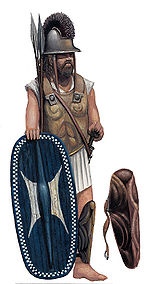Illyrian culture was formed with its characteristic features that distinguish it from neighboring peoples, cultures developed during the Iron Age . She was a native culture that was created in the historic land of the Illyrians , the process of formation of Illyrian ethnos itself , on the basis of internal development of socio- economic and Illyrian society undoubtedly relations with neighboring peoples . Its basic features are expressed in the most important achievements of the Illyrians in the development of their economic and social development in the way of living and understanding of the surrounding world , in the way of pasqyruarit worldly outlook on art them . Besides basic features common to this culture , which are characteristic for all Illyrian land , especially the local observed . In terms of a wide territory , the variety of physical and geographical highlighted , as was the western part of the Balkan Peninsula , about neighborly relationship with the provinces that characterized the development of different socio- cultural , especially pronounced among the backward north qendërevropian most advanced and south - Mediterranean egjeo , these local differences in culture are as understandable as developing uneven socio- economic Illyrians recognized this time . Archaeological records indicate local changes in certain aspects of life and creativity of the Illyrians , which are simply changes the ethnographic character .

.jpg)
According to archaeological data , the Illyrian land in the era of iron distinguished several cultural groups : group ionic or Epirote , which includes the region inhabited by Kaon , Thesprotia , and other tribes Molossians smaller areas in Southern or South Adriatic group taulanto - ardian , which stretches across the coastal plains of the Naretva Vjosa and inhabited by two major tribes and other tribes around them smaller , group or Dasara Devollian in the southeastern province of Albania Korce basin center , group Pelagon in Western Macedonia and he PAIO to Eastern or pirust Mat group , which includes the provinces of the interior of northeastern Albania ( Mat , Debar Kukes ) and he dardan in Kosovo based group Glasinacit plateau of the same name in eastern about Sarajevo and its corresponding province inhabited by Autariatae ; Dalmatian group , which includes the region between the rivers Krka Naretva ; Japod group in the territory of today's Lika and northern - Adriatic group or Liburn , stretching the territory between the rivers Krka Zrmanje . Each of these groups is mainly cultural territories inhabited by tribes or tribal Illyrian major mergers . How were geographically closer these groups , the greater were the cultural similarities between them. Thus , for example , is quite parallel group Japod with neighboring Liburn . In Central Illyria Mat group so closely connected with it that dardan Glasinacit and engage with a broad cultural complex Mat - Glasinac , while in Southern Illyria Devollian group brings in many respects to that Pelagon and Epirote . These local differences and similarities , which derive from a common ethnic basis , once the related conditions of different times of socio- economic and interregional relations , melt the whole Illyrian cultural community , which we see as the language , and in material culture (settlements , tools, weapons , pottery , ornaments , etc. . ) and spiritual ( the art of understanding ) thereof , without requiring a complete unity to the degree of development of the Illyrians . Ethnographic features local culture, as well as the language and dialect , do not affect the unity of the Illyrian culture and its bearers , they are an expression of the diversity and differences within the same culture.

No comments:
Post a Comment